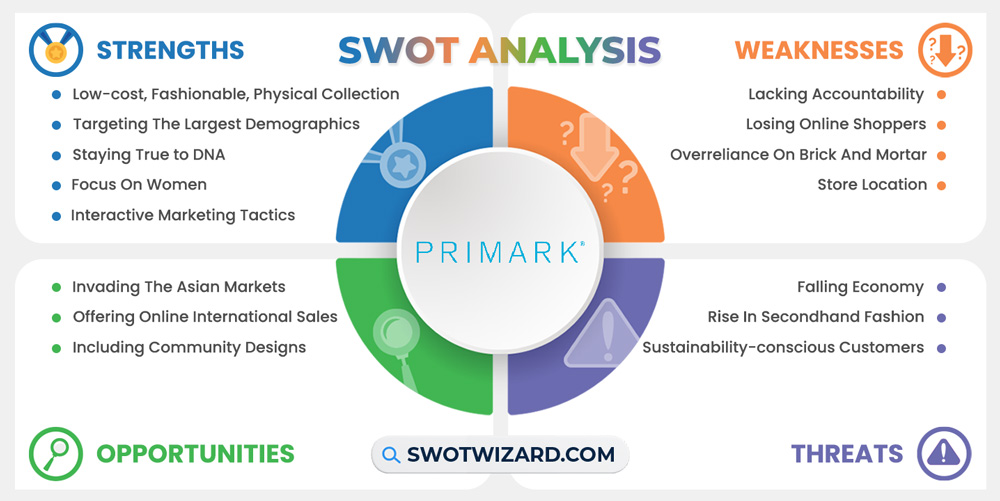Primark is a leading international apparel retailer that has earned its market share by offering cheap but quality clothing. Despite selling $4,391.28 million in 2019, it has recently suffered losses. To understand why a fast fashion giant has fallen in ill times, you can explore the Primark SWOT analysis.
Primark: Company Overview
| Company | Primark |
| Industry | Retail |
| Founded | 13 June, 1969 |
| Founder | Arthur Ryan |
| CEO | Paul Marchant |
| Headquarter | Dublin, Ireland |
| No. of Employees | 71,000+ |
| Annual Revenue | £5,593 million (FY 2021) |
| Website | primark.com |
Founder Arthur Ryan opened the 1st shop in Dublin, Ireland, in 1969 as Penney’s. Its 1st UK store opened in 1973 and was named Primark as J.C. Penney owned the trademark outside of Ireland. In 2006, the company expanded internationally by opening a store in Madrid, Spain.
In 2023, the Primark is an international fast-fashion seller with more than 373 stores in 12 countries. It’s headquartered at Arthur Ryan House, 22–24 Parnell Street, Dublin in Ireland. The company currently employs over 700,000 workers globally.
Product & Services of Primark
Baby Clothing | Womenswear | Menswear | Homeware | Accessories | Footwear | Beauty Products | Confectionery
Primark Competitors
Zara | H&M | Marks and Spencer | Burberry | Prada | Gucci | Chanel
Did You Know?
Primark has had a long-running confusion with how to pronounce its name, along with modifications such as Primani. According to the company, the correct pronunciation is “Pr-EYE-Mark.”
Strengths – Primark SWOT Analysis

Low-cost, Fashionable, Physical Collection: Primark attracts younger generations by offering quality, fashionable apparel at low to moderate prices. The brand stands out from other low-cost clothing brands by creating a “kid in the candy store” store effect on its customers through its physical stores. By offering a wide range of clothing, shoes, bags, and other fashion products with low-price listed on all, it can make customers feel as if they can buy the whole store and walk away with money to spare. This strategy convinces customers to buy more clothes and feel like they are winning massively, which resulted in a 4% sales growth in Primark’s 2019 Q1.
Interactive Marketing Tactics: Aside from its cheap prices, Primark saves money by using the customers to market itself. Its mega store in Birmingham has a “snap-and-share” room where customers can take in clothes and take as many pictures wearing them as they like. Primark also attracts customers with its subtle push towards individuality, for customers to own their fashion rather than being owned by fashion labels. This push towards individuality has convinced many Primark shoppers to proudly display their Primark collections on social media, elevating the brand’s image and presence without any real expenses.
Staying True to DNA: Primark’s core reason for success is its physical stores and the “kid in the candy store” effect, and the brand hasn’t abandoned it even after the rise of virtual marketplaces. Primark doesn’t use its website as a virtual marketplace, but rather as a showcase for its wardrobe collection and a way to incentivize customers to go to its physical shops. The site has a store locator feature on the top left and shows Primark’s entire collection, the price of each item, and sizes. But it insists on checking for physical store availability and finally goes to click and collect if the customers want to buy an item. By keeping no option for virtual purchases, Primark forcefully triggers the intended effect of its physical stores and increases the chance of sales.
Focus On Women: Primark pays exclusive attention to its female shoppers more than men. On average, women are responsible for 70-80% of all consumer purchases, mainly due to making major financial decisions for their families. Compared to men, women look for pre-owned products 18% less, care about product features 16% less, hunt for better deals 17% less, care 6% less about flexible delivery. And they are 10% better at shopping online since the advent of COVID-19. This is why Primark often displays its women’s collection over others in its physical stores and prioritizes featuring women’s fashion images on its webpage and online marketing.
Targeting The Largest Demographics: By retailing an affordable fashion collection, Primark accesses the largest demographic available. Primark’s main sales come from consumers who care more about price and volume than quality. Primark also sells the same design in many colors with slight alterations to fit the taste of various ages and classes. On top of these shoppers, Primark also attracts frugal shoppers who prefer quality over quantity, by providing fashionable and adequate quality collections at lower prices than premium brands.
Weaknesses – Primark SWOT Analysis

Lacking Accountability: Primark has faced massive scrutiny regarding its product manufacturing and sourcing for years. While it does attempt to clarify its practices and the ethicality of its manufacturing, it fails to provide a proper explanation for its international operations.
Other than mentioning memberships and supporting groups, the brand does not mention any tangible steps and effects it has had on ensuring worker pay and safety. It provides data about its sustainability and employee management for UK stores and warehouses and avoids talking about international employee management completely.
Losing Online Shoppers: Primark’s stance of enforcing physical shopping may net it more sales on the surface, but it is losing all prospective customers who are exclusively online shoppers. 35–44-year-old customers are the largest group in the UK who buy fashion items online, and they have high purchasing power.
62% of women in the UK prefer to shop online, and 44% of consumers in 2018 purchased fashion gear online 2-3 times within 3 months. By choosing not to sell to these shoppers, Primark is losing out on female shoppers who are part of its targeted demographic.
Overreliance On Brick And Mortar: By relying on physical stores, Primark exposes itself to labor costs, high rent and maintenance costs, and limits the brand’s reach to a geographical area. Also, Primark can face issues such as a pandemic, natural disasters, inventory mismanagement, theft, and more by only offering physical sales. In 2020 Q3, Primark announced to have a 75% sales drop due to its physical stores becoming compromised.
Store Location: Primark keeps its prices low by placing most of its stores on the outskirts in low-value lots, but it makes them difficult to spot. For example, the Primark on Bath is at 38 – 39 Stall Street, which can get lost in a sea of other shops and vendors. Many stores, such as those in Blackburn, Corby, Greenock, and Harrow, can be hard to reach and hard to spot if customers are casually exploring.
Opportunities – Primark SWOT Analysis

Invading The Asian Markets: Primark can open its doors to Asian Markets, such as the markets in India, Thailand, Japan, and Nepal. Japan, in particular, can be a great market for Primark, as its younger generation is heavily invested in fast fashion, but customers don’t like to spend much on apparel.
Offering Online International Sales: Primark can reduce costs and increase sales by exclusively offering online purchase options outside of the UK and the US. European countries such as France and Germany have 31% and 36% online shoppers, respectively, and Primark can access these customers without losing its DNA in native markets.
Including Community Designs: Primark can hold contests for aspiring fashion designers and sell the winning designs. This decision will raise its image in front of the public, inject new design philosophies into its collection, boost sales, and create profitable bonds with potential leading designers.
Threats – Primark SWOT Analysis

Sustainability-conscious Customers: After the pandemic European customers have become more careful about their environmental footprint and sustainability. In a survey with 2004 participants, 57% had changed their lifestyle to lessen their environmental impact. Ages 25-44 in the UK have had a significant rise in clothes shoppers who care about sustainability. Eventually, Primark will have to be fully accountable for its supply chain management and provide proper data on its operational behaviors to appease this crowd.
Rise In Secondhand Fashion: Social media have normalized and popularized thrifting and reusing old clothing. Vintage fashion is trending for reducing carbon footprint and offering a way out of being labeled mediocre. In 2019, the secondhand market expanded 21 times faster than the new clothing market. With customers going for even cheaper and unique fashion, Primark may fail to keep up.
Falling Economy: The consumer purchasing power is reduced, and it is not going to recover any time soon. As Primark relies on high-volume sales, it may see a significant drop in revenue caused by this issue.
[Bonus Infographic] SWOT Analysis of Primark

Recommendations for Primark
To save its business, Primark can consider these options.
- Primark should make tangible data about its international worker management publicly available.
- It should consider creating a sub-brand specializing in selling vintage clothing.
- It can lower its cost by offering online sales internationally.
- It can change the outer appearance of its stores, making it stand out even in low-value lots.
Frequently Asked Questions (FAQs)
Are Primark sizes smaller than standard?
Primark clothes can be up to 4 sizes smaller than standard.
Which Primark store is the largest?
Primark's Birmingham outlet is its largest, towering across 160,100 sq ft.
Final Words on Primark SWOT Analysis
Primark has profited so far by bucking the trend and opting for physical stores only. However, in this economy, its strategies won’t help it survive. Either it has to dip into lower brackets or establish itself as a luxury brand to grow in such an economy.
References
- Wikipedia contributors. (n.d.). Primark. Wikipedia.
- Burke, M. (2021, July 6). Men vs Women Shopping Statistics, Behaviors & Other Trends. JungleScout.
- Chevalier, S. (2022, November 24). Online clothing market in the UK – Statistics & Facts. Statista.
- Diep, C. (2022, July 4). Shopping behavior in Japan – statistics & facts. Statista.
- Farra, E. (2020, November 21). 2020 Was a Big Year for Old Clothes: How Vintage, Secondhand Fashion, and Upcycling Took Off. Vogue.
- Granskog, A., & Lee, L. (2020, July 17). Survey: Consumer sentiment on sustainability in fashion. McKinsey & Company.
- Fast Fashions in Japan. (2016, July 29). Guidable.
- Henry, A. (2015, March 4). When It Makes Sense to Buy Quality Instead of Saving Money. Lifehacker.
- Hinsliff, G. (2019, May 28). Cheap and cheerful: why there’s more to Primark’s success than you thought. The Guardian.
- Khusainova, G. (2021, January 28). The Secondhand Market Is Growing Rapidly, Can Challengers Like Vinokilo Thrive And Scale? Forbes.
- Kraaijenbrink, J. (2019, January 22). Why Is Primark So Successful? The Power Of Alignment. Forbes.
- Murphy, C. B. (2022, September 18). Brick-and-Mortar Stores: Types, Advantages, and Disadvantages. Investopedia.
- Nelson, A. (n.d.). Women Drive Majority of Consumer Purchasing and It’s Time to Meet Their Needs. Inc.
- Primark – what’s the secret to its success? (n.d.). Local Data Company.
- PricewaterhouseCoopers. (2023, February 16). 69% of consumers hold back on non-essential spend as cost of living rises; 90% adopt cost-saving behaviours: PwC Consumer Insights Survey. PwC.
- Our Ethics. (n.d.). Primark.
- About Us. (n.d.). Primark.
- Spragg, J. (2019, September 9). 10 Things You Didn’t Know About Primark. Primark.
- Ruiz-Alba, M. (2012, November 26). 8 reasons why Primark is cheap. Medium.
- Russell, C. (2019, June 14). How Primark Reinvented The Department Store And Made The Biggest Store Ever. Forbes.
- SICURELLA, S. (2021, June 18). When Second Hand Becomes Vintage: Gen Z Has Made Thrifting A Big Business. NPR.
- Smith, P. (2021, November 1). UK: sustainable fashion purchase by age and gender 2020. Statista.
- Davis, S. (2018, February 16). Why Primark is thriving on today’s high street. Prosper.
- Villanueva, J. (2020, July 3). Primark Sales Drop 75% While Competitors Try To Speed-Up Their Digital Transformations. Forbes.




